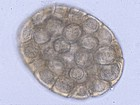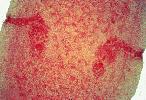Difference between revisions of "Dipylidium caninum"
| Line 12: | Line 12: | ||
== ''Dipylidium caninum'' == | == ''Dipylidium caninum'' == | ||
[[Image:Dipylidium caninum.jpg|thumb|right|150px|''Dipylidium caninum'' - Taenia of Dogs and Cats Joaquim Castellà Veterinary Parasitology Universitat Autònoma de Barcelona]] | [[Image:Dipylidium caninum.jpg|thumb|right|150px|''Dipylidium caninum'' - Taenia of Dogs and Cats Joaquim Castellà Veterinary Parasitology Universitat Autònoma de Barcelona]] | ||
| + | [[Image:Dipylidium caninum proglottid.jpg|thumb|right|150px|''Dipylidium caninum'' proglottid - Courtesy of the Laboratory of Parasitology, University of Pennsylvania School of Veterinary Medicine]] | ||
=== Significance === | === Significance === | ||
''D. caninum'' is a very common parasite of dogs and cats, growing to 50cm long in the small intestine. It is of minor clinical significance causing no more than occasional anal irritation. Diarrhoea may result if the tapeworms are present in large numbers. The proglottids are motile and can upset owners when they drop onto the furniture or floor. | ''D. caninum'' is a very common parasite of dogs and cats, growing to 50cm long in the small intestine. It is of minor clinical significance causing no more than occasional anal irritation. Diarrhoea may result if the tapeworms are present in large numbers. The proglottids are motile and can upset owners when they drop onto the furniture or floor. | ||
Revision as of 14:31, 22 December 2008
| This article is still under construction. |
|
|
Dipylidium caninum
Significance
D. caninum is a very common parasite of dogs and cats, growing to 50cm long in the small intestine. It is of minor clinical significance causing no more than occasional anal irritation. Diarrhoea may result if the tapeworms are present in large numbers. The proglottids are motile and can upset owners when they drop onto the furniture or floor.
Recognition
The gravid segments can be differentiated from those of Taenia spp as they are:
- oval in shape
- have two lateral genital pores.
Life-Cycle
The egg packets are likely to be dropped in the same places as the eggs of the intermediate host, the flea. When ingested by the flea larvae, the oncosphere transforms to a cysticercoid which is infective by the time that metamorphosis is complete. Flea infestation provokes exaggerated grooming behaviour and the cat or dog becomes infected with Dipylidium, when it swallows an infected flea. Prevention of re-infection therefore requires advice on flea control.

